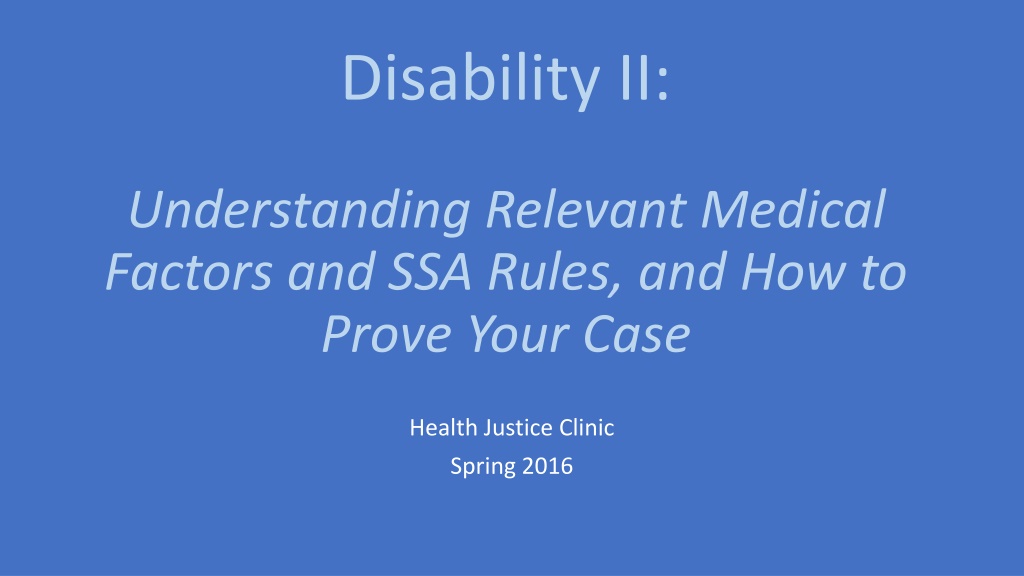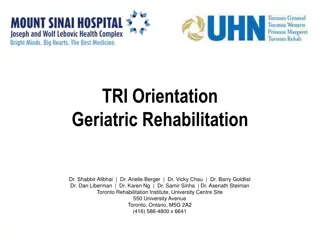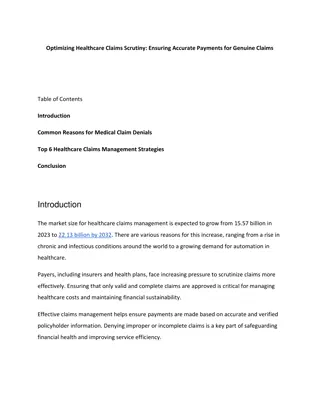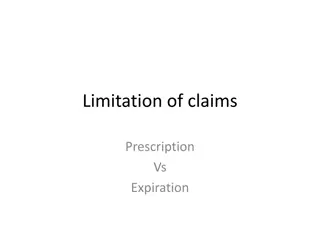Understanding Medical Factors for Disability Claims
This content delves into the intricacies of understanding relevant medical factors and Social Security Administration (SSA) rules in proving disability cases. It covers crucial steps such as assessing if the claimant meets equal listings, evaluating work capacity based on residual functional capacity (RFC), reasons for claim denials, and strategies to address common pitfalls like lack of consistent care and treatment compliance issues. Emphasizing the importance of medical provider opinions, the content provides insights on proving disability cases effectively.
- Disability claims
- Medical factors
- SSA rules
- Social Security Administration
- Medical provider opinions
Uploaded on Oct 09, 2024 | 0 Views
Download Presentation

Please find below an Image/Link to download the presentation.
The content on the website is provided AS IS for your information and personal use only. It may not be sold, licensed, or shared on other websites without obtaining consent from the author. Download presentation by click this link. If you encounter any issues during the download, it is possible that the publisher has removed the file from their server.
E N D
Presentation Transcript
Disability II: Understanding Relevant Medical Factors and SSA Rules, and How to Prove Your Case Health Justice Clinic Spring 2016
Step 3: Does claimant meet/equal listing? Listings have very specific findings required --> high standard difficult to meet, but as advocate, you must examine all possible listings pay close attention to introductory section and definitions at beginning of each listing Client may equal a listing in some circumstances: If almost meets listing and can argue that client equals a listing If client s impairment is not included in the listings but is functionally equivalent to a listing for a similar MDI Must have doctor s opinion to support argument that client equals a listing
Steps 4 & 5: Can claimant work? Can claimant do past relevant (step 4) or any (step 5) work given impairments? Residual functional capacity ( RFC ) What can the claimant do in spite of her/his impairments? Strength classifications: Heavy, Medium, Light, Sedentary -- based on ability to sit, stand, walk, lift, carry. Also takes other physical and mental limitations into consideration: E.g., manipulative limitations, environmental restrictions, heights Mental RFC basic mental demands of unskilled work (ability to get along, follow simple directions, complete SRRTs without constant supervision) REMEMBER: This is what claimant can sustain on a full-time basis, 5 days/week, 8 hrs/day or equivalent
Why do people get turned down? Adjudicators want objective findings HIV subjective, self-reported, unmeasurable symptoms e.g. fatigue, pain, sleep problems Cancer patients often have self-reported cognitive difficulties chemo brain Get opinion from medical provider that client s subjective symptoms are consistent with medical findings and clinical observations, e.g. history of the illness, side effects of treatment Statements in records, such as asymptomatic, doing well Get medical provider to put these statements in context ( doing well for someone who had a nadir CD4 of 15 and almost died, or similar for cancer) Duration issues applying early in the illness very sick, but responding well to medications Get medical provider to give an opinion on prognosis
Why do people get turned down? Lack of consistent care, good records Get client into HIV case management Supplement with statements from providers Treatment Compliance Issues Requirement to follow prescribed treatment: 20 CFR. 404.1530, POMS DI 23010.005 consider mental health, cost, other access issues Transportation, cost issues, stigma, mental health Substance abuse Find period of sobriety in the records Get an opinion from provider that substance abuse doesn t materially contribute to the disability
Symptoms, signs, and laboratory findings Per SSA Symptoms - own description of physical or mental impairment. Not enough to establish that there is a physical or mental impairment. Signs anatomical, physiological, or psychological abnormalities which can be observed, apart from claimant s statements (symptoms). Signs must be shown by medically acceptable clinical diagnostic techniques. Psychiatric signs must be shown by observable facts that can be medically described and evaluated. Laboratory findings - anatomical, physiological, or psychological phenomena shown by medically acceptable laboratory diagnostic techniques including chemical tests, electrophysiological studies, X-rays, and psychological tests.
SSAs evaluation of pain and other symptoms Symptoms, such as pain, fatigue, shortness of breath, weakness, or nervousness, will not be found to affect ability to do basic work activities unless medical signs or lab findings show that MDI is present, which could reasonably be expected to produce pain or other symptoms alleged. Evaluate intensity and persistence of symptoms to determine the extent to which symptoms limit capacity for work All available evidence used to evaluate the intensity and persistence symptoms
Evaluating (medical) opinion evidence Medical opinions statements from: physicians, psychologists or other acceptable medical sources reflect judgments about nature and severity of impairment(s), including symptoms, diagnosis and prognosis, what claimant can still do despite impairment(s), and physical or mental restrictions.
Factors in weighing medical opinion evidence SSA considers: Examining relationship source actually examines claimant Treatment relationship - length & frequency, nature & extent Supportability - evidence backs up opinion, better explanation Consistency - opinion with record as a whole Specialization - + weight to specialists than non-specialists NOTE: ALJ reviews DDS determinations de novo.
Proving Disability Medical Records Affidavits/Statements from Doctors & other health care providers Social Workers, Case Managers The client Employers, friends, family who are aware of limitations, other relevant facts Other records, e.g. School Records Work records
What to get from the provider An opinion that the client meets a particular listing An explanation of the medical issues in the case, including how various conditions may be related An overview of the medical history and course of treatment Prognosis, duration Observations of client during visits, including mood, appearance, reports of subjective complaints
What to get from the provider Residual Functional Capacity Opinion Opinion about credibility of subjective symptoms, med side effects I am aware that patient complains of being unable to cook dinner without sitting on a stool . credible based on medical findings. Opinion about consistency of client s statements about functional limitations with medical findings and history
What to get from the provider Reality check about effects of treatment Context for statements such as doing well asymptomatic Explanation of any compliance problems e.g. depression, cognitive deficits, side effects, chaotic life, etc. Opinion re materiality of substance abuse
What to get from client & 3d parties re functioning What can s/he do? Housekeeping, transportation, grocery shopping (uses a cart/scooter) Concentration/attention issues: Remembering medical appointments? banking? Helping child with homework? Paying bills? Following medication schedule? Assemble furniture that comes in a box? Read a book, magazine? Follow TV, movie How long at one time? Breaks? How long, how often? Naps? How long, how often? Assistance from family, friends, case managers? Frequency of medical appointments, illnesses
What to get from client & 3d parties re mental functioning Mental Health symptoms Concentration, memory, attention Mood Social isolation Anxiety, intrusive thoughts Ability to be around other people, take instructions Anger issues























